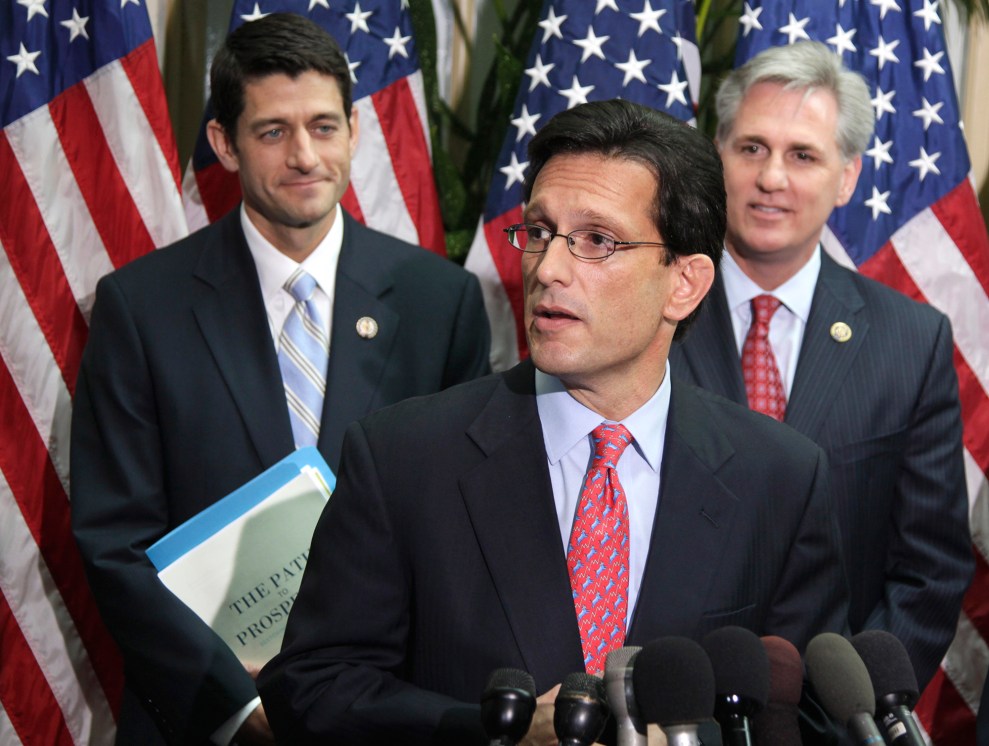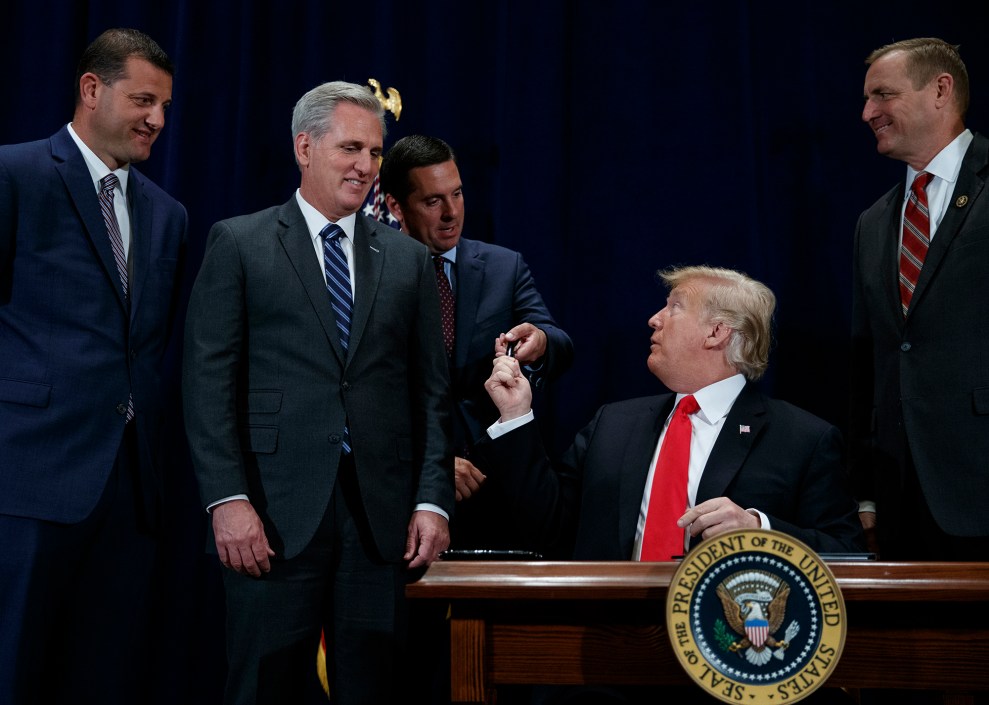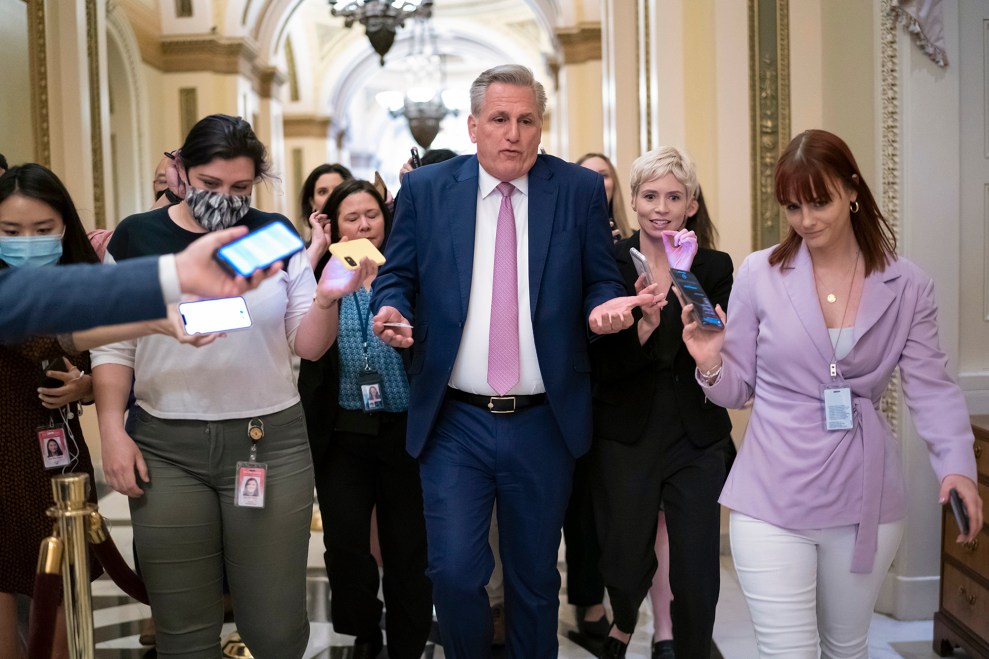How Kevin McCarthy Became the Last “Young Gun” Standing
In the summer of 2011, as Washington deadlocked over the once routine task of raising the nation’s debt ceiling, Kevin McCarthy, then the House GOP whip, decided to mix things up. At a closed-door caucus meeting, the California Republican cut the lights to screen a clip from the heist movie The Town, where Ben Affleck and Jeremy Renner plot a violent act of revenge.
“I need your help,” Affleck’s character says. “I can’t tell you what it is. You can never ask me about it later. And we’re gonna hurt some people.”
When the lights flicked on, Allen West, a first-term Florida congressman who had become a conservative hero after firing a gun past an Iraqi detainee’s head, rose to offer a version of Renner’s response.
“I’m ready to drive the car,” West said.
For McCarthy, his political ambitions have always come with a catch: To get where he wanted to go, he first had to hand over the keys. His elevation to speaker of the House in January on the 15th ballot was the culmination of his life’s work and a demonstration of his powers. In nailing down a belligerent caucus, McCarthy leaned on relationships cultivated over a decade-and-half on the campaign trail, at the Capitol, and on the fundraising circuit. But it was also a reminder of the compromises he made to get there. McCarthy won the gavel, but not the authority it traditionally brings, by ceding control to the insurrectionists and austerity-obsessed hard-liners who blocked his nomination 14 times. His victory was in many ways the story not just of his own career, but of the trio of Republican “Young Guns” with whom he rose through the ranks. McCarthy is the last one of them standing, because he already surrendered long ago.

When McCarthy posed with Reps. Paul Ryan (R-Wisc.) and Eric Cantor (R-Va.) for a Weekly Standard cover in the fall of 2007, their party was undergoing a generational collapse. The Republican Revolution of the 1990s had produced brazen corruption and interventionism, and a string of ethically challenged leaders. One GOP speaker of the House resigned in disgrace. Another, Dennis Hastert, turned out to be a child molester. What figureheads the party had were not just ineffectual, but kind of wooden. Democrats, on the other hand, had Barack Obama, someone conservatives accused of actually being too cool to be president. The three lawmakers, the magazine suggested, offered a new foundation. In the cover photo, Ryan’s hair is parted like a 1920s banker. Cantor looks skeptical, as if someone has just passed gas. McCarthy, standing awkwardly off to the side, looks like that someone is him.
The key to McCarthy’s politics wasn’t any particular code, but the lack of one—anyone who won a primary and hit their fundraising marks was invited into the club.From the start, the “Young Guns,” as the cover read, were more a branding exercise than an argument, a phrase chosen because “Capitol Hill careerists fast approaching middle age” doesn’t sound as good. They were the future because someone had to be. In the magazine’s framing, and in the trio’s subsequent 2010 bestseller, Young Guns: A New Generation of Conservative Leaders— Fred Barnes, a Weekly Standard editor whose son worked for McCarthy, wrote the forward—Cantor was “the leader” and speaker-in-waiting. Ryan was “the thinker,” a budget-wonk who wrote about reining in Social Security and Medicare, and saving America from the “soft despotism” of a “takers” mentality. McCarthy’s portion of the book was largely bereft of policy specifics. He was “the strategist.”

Eric Cantor flanked by fellow Young Guns Paul Ryan andKevin McCarthy.
Carolyn Kaster/AP
A longtime Republican staffer handed a southern California district by his retiring boss, McCarthy spent much of his first campaign fundraising for other candidates. Once in office, he pored over demographic data and election returns, nurturing a reputation as a campaign savant. He read the Almanac of American Politics on cross-country flights. He dragged colleagues to watch Moneyball for strategic inspiration (movies, it seemed, were his thing). In Young Guns, McCarthy described the kind of candidates he believed would return the party to greatness—people outside politics, who would not only run better campaigns, but be better legislators.
But McCarthy wasn’t a stickler. For a long time, the joke about the candidates who bore the Young Guns imprimatur was that they were actually kind of old. In 2010, after the candidate program was adopted by the National Republican Congressional Committee, the Daily Beast calculated that the median “Young Gun” was almost 50. The oldest Young Gun on record, Amie Hober, was 74.
Ideology, temperament, and biography were negotiable too. The now-retired Rep. Louie Gohmert (R-Texas), a “FWD: FWD: FWD” email chain in human form, was listed in the book’s appendix as an original member. In due time, Lauren Boebert and Madison Cawthorn would be NRCC-designated Young Guns. Wendy Rogers, who was later censured by the Arizona state senate for calling for her enemies to be publicly hanged, was twice a failed Young Gun. George Santos—whose campaign manager reportedly fundraised by impersonating McCarthy’s chief of staff—claimed to be a Young Gun, and in a surprise twist, actually was.
I am excited and humbled to be named an official @NRCC Young Gun! We are one step closer to taking back the House in November and stopping socialism once and for all! pic.twitter.com/kGUFnYVZGS
— George Santos (@Santos4Congress) June 14, 2022
The definition of a Young Gun proved so broad as to be meaningless. The key to McCarthy’s politics wasn’t any particular code, but the lack of one—anyone who won a primary and hit their fundraising marks was invited into the club. That lack of standards, and willingness to embrace the party’s increasingly rabid rank-and-file, was an ideology every bit as significant as Ryan’s austerity—and ultimately more useful. McCarthyism was whatever Republicans were in the mood for.

The Young Guns book was a Polaroid of anti-Obama conservatism, snapped just before its protagonists assumed the burdens of actual responsibility. It detailed the ways Democrats—and their health care law in particular—were ruining what America was, and how Republicans would save it. When they won, the bill came due. The tension between the image of three Young Guns in charge and the reality of their caucus has defined Congress ever since.
One after another, this new generation of conservative leaders was undone by the new generation of conservatives they had anointed themselves to lead—and who demanded more than the Triumvirate could deliver. Hard-liners forced a 16-day government shutdown in 2013 by refusing to pass a budget unless it defunded the Affordable Care Act. These GOP representatives disliked Obama, but it sometimes seemed like they disliked their leadership even more. Cantor fell first, losing a 2014 primary to an economics professor who said the incumbent had sold out conservatives. The former majority leader, who now works at a Wall Street investment bank, told Washingtonian a few years later that he “never believed” his rhetoric about repealing Obamacare while there was still a Democrat in the White House—but that he let conservatives think otherwise because the “anger” worked in his favor. His defeat confirmed the obvious: Republican leaders had unleashed forces they could not control.
McCarthy looked like he’d be next. His 2015 bid for speaker in Cantor’s wake failed after resistance from a group of conservatives led by Rep. Jim Jordan (R-Ohio). The caucus united around Ryan, whose budget—so severe and unpopular that it helped Obama win reelection after the Young Gun joined the 2012 Republican presidential ticket—was a point in his favor. But Ryan too, struggled to control an unwieldy majority. The Weekly Standard didn’t set the tone for conservatives in Washington—the House Freedom Caucus did.
“It’s sad to see a man that I think has so much potential just totally sell himself.”Trump, though, offered McCarthy another chance. While Ryan and even Mitch McConnell sometimes expressed frustration with the man in the Oval Office, McCarthy charted a different course. During Trump’s campaign, he stayed close while others denounced him, eventually becoming his chief enabler on the Hill—a man who questioned nothing, propping up a man who would say anything. He egged on the president’s lies about the 2020 election and demonstrated his fealty behind the scenes, once presenting the commander in chief with a jar of Starbursts with Trump’s least-favorite flavors removed. There was never a better time in Republican politics to be a nihilist.

House Speaker Kevin McCarthy with former Rep. Devin Nunes and former president Donald Trump.
Carolyn Kaster/AP
On January 6th, 2021, as a mob of Trump supporters besieged the Capitol to block the certification of his loss, McCarthy called the president and asked him to call off the dogs.
“Well, Kevin, I guess these people are more upset about the election than you,” Trump said.
“More upset?” McCarthy replied, according to one account. “They’re trying to fucking kill me.”
But getting ahead in the GOP meant taking the death threats in stride. Although in the riot’s aftermath, McCarthy said that Trump “bears responsibility” and briefly considered a censure vote, he ultimately stuck with the president. He joined most House Republicans in voting to reject the election results when the chamber reconvened, and a few weeks later, after the tear-gas had cleared, flew to Mar-a-Lago to make sure there were no hard feelings. Trump, prone to handing out disparaging epithets, gave McCarthy a pet name instead: “My Kevin.”

Today, Young Guns makes for a strange read. The book reflects wishful thinking for a golden age that never materialized, from a magazine that went out of business during the Trump presidency. Conservatives craved something coarser and meaner than what Beltway lifers prescribed. The big idea—Ryan’s budget—was political poison, the sort of bloodless think-tank pablum that Trump made a mockery of as a candidate. The book name-checks Mitt Romney and Meg Whitman. “It’s the party of Rubio, Jindal, and Daniels,” Cantor wrote. Instead, it got “Kanye. Elon. Trump.”
One of the promising candidates McCarthy promoted in the book was Adam Kinzinger, a 32-year-old Illinois Air Force vet who once received an award from the Red Cross for rescuing a woman from a knife attack. The YG Action Fund, a super-PAC run by an ex-Cantor aide, later waded into a primary, backing him against a 10-term Republican incumbent. Kinzinger, McCarthy said, would bring “accountability back to Washington.” In a roundabout way, he was right; Kinzinger, who retired in January, voted to impeach Trump after the insurrection, and defied McCarthy by serving as one of two Republicans on the special January 6 committee.

House Minority Leader Kevin McCarthy heads to his office surrounded by reporters.
J. Scott Applewhite/AP
“It’s sad to see a man that I think has so much potential just totally sell himself,” Kinzinger said recently. McCarthy, he predicted, would not even win his election for speaker.
He almost didn’t. But McCarthy made it this far by embracing shamelessness as a value and appeasement as a path to power. To win, he needed to flip the guy who compared the rioters to tourists (Andrew Clyde of Georgia), and he needed to bring along the woman who quoted Hitler on January 5th (Mary Miller of Illinois). He needed the vote of the representative who addressed a white nationalist conference and shared a meme of himself murdering a colleague (Paul Gosar of Arizona), and one from the person who addressed a white nationalist conference and posted on Facebook about executing Nancy Pelosi (Marjorie Taylor Greene). He agreed to gut his own powers and put the House Freedom Caucus behind the wheel. Above all, he needed to reassure some of Washington’s most intransigent people that he was, once again, a new generation of conservative leader, poised to move his party on from failures of the past.
“He’s different,” Rep. Brian Mast of Florida said in his speech nominating McCarthy before the eighth vote. “He’s not Paul Ryan.”
Copyright
© Mother Jones
